
Laryngospasm is a disease of the respiratory tract, which manifests itself in the form of short-term asphyxiating attacks. This disease can develop in adults, but most often laryngospasm suffers from small children - in most cases those that are not yet two years old. Less often - preschool age.
Children are the category that is most susceptible to the likelihood of these painful seizures, sometimes even fatal. What are the symptoms of laryngospasm in children, what should the parents do in this case, and how to prevent the appearance of the following seizures - let's talk about this in the article.
Contents
- 1 Features of the disease
- 1.1 Who are at risk
- 1.2 Symptoms
- 2 Emergency care
- 3 Treatment
- 4 Prevention
Features of the disease
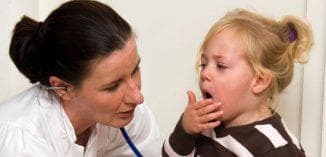
The main characteristic of laryngospasm is its specific manifestations. The attack always begins suddenly and consists in convulsive and involuntary compression of the muscles of the larynx.
As a result, the child becomes difficult to breathe, sometimes he can not even speak and make sounds.The attack can be as easy when the lumen is narrowing minimally, and heavy, when no gaps are visible at all - in this case, urgent medical intervention and help is required.
The most vulnerable category of children is under 2 years old. Especially often are prone to laryngospasm attacks, those children who are forced to be on artificial feeding.
Who is at risk
Consider which categories of children are most susceptible to attacks of laryngospasm
- Those babies who are on artificial feeding.
- Children suffering from a deficiency of calcium, vitamin D and associated rickets, even if the latter is mild.
- Children with epilepsy and edema of the brain.
- Hyperactive toddlers who can not stay in the same position for more than a minute.
- Such diseases as bronchopneumonia, chorea, spasmophilia, various inflammations and pathologies of the upper respiratory tract often lead to the appearance of attacks of laryngospasm.
- If the baby is allergic, he is at risk.
- A sudden strong fright, hysterical cries or too much laughter can also trigger an attack.
- The ingestion of a foreign body in the throat is a possible cause of infant laryngospasm.
- Incorrect metabolic processes occurring in the body are a possible cause of laryngospasm in a child.
- Birth injury. In this case, seizures can begin in a child of very small age, literally within a couple of months after birth.
On video help for children with laryngospasm:
Symptoms of
How exactly laryngospasm manifests in children, we will consider.
Seizures can occur in a child several times a day. Most often they happen in the daytime, but sometimes can occur at night. It should be noted that all the signs listed below do not have any prerequisites - the attack appears suddenly, without any preparatory stages. Therefore, if a child has an attack of laryngospasm, the parents should be constantly on guard - at any moment the next one may start.
Tags:
- The child is suddenly caught in a breath. He does not have enough air, the child has, so-called, inspiratory dyspnea - when there is no way to breathe normally.
- The mouth involuntarily opens, the head throws back. Muscles of the abdominal cavity and neck become very strained at the same time.
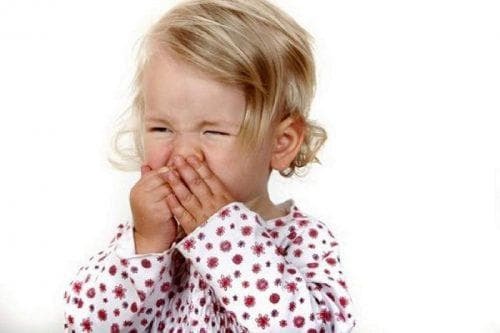
On the photo, the symptoms of laryngospasm in children
- The back of the child bends.
- When the baby tries to breathe, he does it so intensively that you can observe the gap between the ribs with the naked eye - they seem to be drawn in during the inspiration.
- Inhale wheezing, loud.
- The facial skin turns pale, and the area around the lips can even turn blue.
- The baby is covered with a cold sweat.
These are symptoms of mild laryngospasm. If the attack is delayed or complicated by other diseases, colds or congenital pathologies, the symptoms may worsen.
To severe manifestations of laryngospasm are:
- Loss of consciousness, fainting.
- Cramps of the extremities.
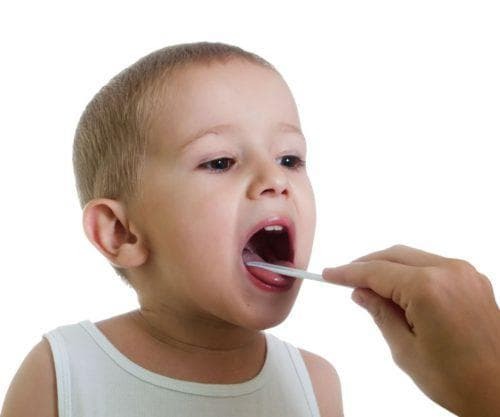
On the photo - the diagnosis of laryngospasm in children
- The appearance of foam in the corners of the mouth. In general, a severe attack of laryngospasm is very similar in symptomatology to epileptic.
- Sometimes, especially if the child is small, he has an involuntary urination or defecation.
Children usually develop short-term seizures. Most often they last for several seconds, but in severe cases they can reach up to 2-3 minutes. After the attack safely passed, the child falls asleep for a short time - the body needs time to recover. Before falling asleep, the baby usually takes a very deep breath.
One should be very careful not to miss these seizures, and in time to help the child. In case of non-presentation or untimely delivery of it, the attack of laryngospasm can end very tragically.
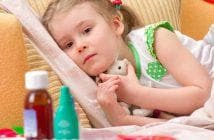 How to use tea with raspberries at the temperature of a child, and how effective this tool is, will help to understand this article.
How to use tea with raspberries at the temperature of a child, and how effective this tool is, will help to understand this article.
And here's how to apply chamomile for a child's cold, and how effective this tool is, is indicated in this article.
It will also be interesting to learn how to distinguish a cold from a virus in a child: http: //prolor.ru/g/ simptomy-g / kak-otlichit-prostudu-ot-virusa.html
But how is acute pyogenic adenoiditis treated in a child, and what drugs are bestuse is specified in this article.
Emergency care
How to help your baby if he has had an attack of laryngospasm. Some useful recommendations for parents.
If you notice a son or daughter having the above symptoms, call for an ambulance immediately. Meanwhile, manage yourself. The first step is to find out - the child can not breathe in or out. If the second, it is possible, in his throat, a foreign body. In this case, turn the baby upside down so that his chest is at the level of your knees. If he has any foreign matter in his mouth, this position will help the baby to spit it out faster. If you can not get your object from the throat with your fingers, you should press the solar plexus upwards - this method usually works well.
On video, what to do with laryngospasm in children( algorithm):
The child should be reassured, for this it is better to take him in his arms. Ensure fresh air in the room. Often, attacks of laryngospasm are caused by an allergy to dust, particles of wool and other pathogens. Fresh air will reduce their concentration in the room. The air flow can also increase the oxygen concentration in the room. Lack of the latter can sometimes cause an attack of laryngospasm.
It is necessary to unfasten the fasteners on the baby's clothes, and if it's a baby baby, unwrap it. Nothing should hinder his free breathing.
Dampen the fleece with ammonia and bring it to the baby's nose. It is necessary that he breathes caustic couples - sometimes this alone is enough to bring the baby "to life".
Face it with water or wipe with a damp cloth. If the attack is easy, you can give a little water to drink.
If an infant is an infant, an unscheduled bathing in warm water can help.
Often, doctors advise somehow to try to distract the child: a variety of tricks are used, such as pulling at the nose, slightly pinching. You can even try to induce vomiting, pressing the root of the tongue of the baby's finger.
If the house has a humidifier or steam generator, then at the time of the attack it's time to turn it on. Moistening and softening of dry air can remove perspiration in the throat, and help the child recover faster.
If parents know that a baby can have an attack of laryngospasm or have to do inhalations from time to time, then probably there is a nebulizer at home. If an attack occurs, you can do inhalations with a soda solution, an alkaline mineral water, Pulmicort. Very often such inhalation can quickly and reliably stop the attack of laryngospasm.
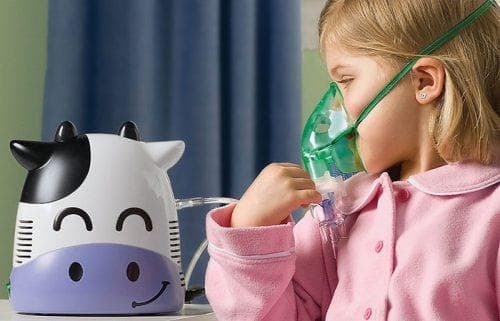
In the photo, use of a nebulizer for a child
If the attack is delayed, it is necessary to give the infant artificial respiration "mouth to mouth" before the arrival of physicians. And if the case is very serious, and the child has started asphyxia, it is necessary to do an indirect heart massage to prevent a fatal outcome.
If the attacks of laryngospasm in a child are in severe form, it is usually mandatory to put it in the hospital under the supervision of otolaryngologists. In the hospital, doctors must find out the cause of the attacks and, based on this, prescribe the optimal treatment.
Treatment of
How is medication for children's laryngospasm carried out.
Laryngospasm is treated, eliminating in the first place the cause that caused it. In each individual case of the disease, this cause can be different: from the banal shortage of calcium to the dropsy of the brain.
Often, doctors recommend that the child make an enema with hydrochloride, which at the same time cleanses the intestines and relieves convulsions.
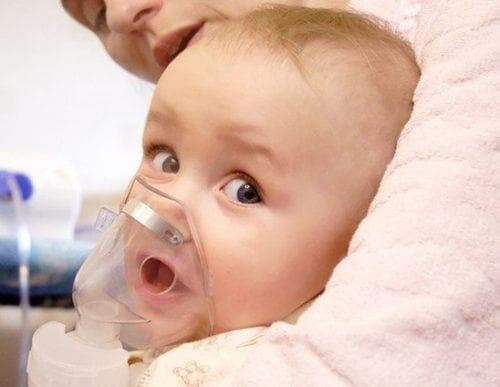
On the photo - inhalation solution by a child
0.5% solution of potassium bromide is a medicine that in the case of laryngospasm helps almost guaranteed. Dosage in each case the doctor appoints individually.
You may also be interested in learning how to distinguish an allergy from a cold in a child.
It will also be interesting to know what to give to a child for prevention of colds, and which remedy is most effective in this case.
But how to cure chronic tonsillitis in a child, and what medicines are most effective in this case, will help to understand this article.
It will also be interesting to know which antibiotic is best for a child's cold, and which one is the most effective, is indicated in this article.
But how to cure a tracheitis in a child, and whether it is possible to do it at home, is described in detail in this article.
Prevention

What steps should parents take to ensure that the attacks of laryngospasm in the son or daughter are no longer repeated.
It is necessary to provide enough vitamin D and calcium for the baby. To do this, use the special products sold in the pharmacy. Vitamin D in the form of liquid solutions - excellent prevention of rickets, as well as directly related to it attacks of laryngospasm.
Breastfeeding - is an excellent means of preventing and preventing laryngospasm in children. If a mother has the opportunity to feed her child naturally, it's better to do so. In this case, the probability of occurrence of such seizures can be significantly reduced, and often not allowed at all.
If the baby has the first attack of laryngospasm, you should definitely get a nebulizer. This inhalation device can greatly help cope with sudden attacks of laryngospasm in a child.
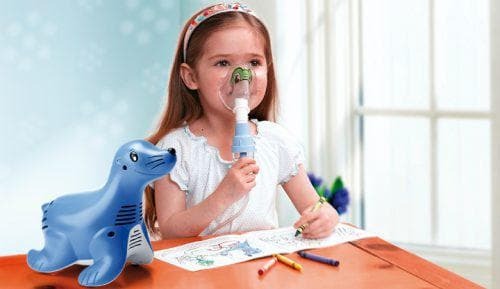
On the photo- use of a nebulizer by a child
Watch the level of humidity in the baby's room - too dry air can irritate the throat. It is also necessary to ensure regular airing of the room in order to exclude a high concentration of allergens and dust.
Do the baby massage, perform the procedures for hardening. All this will help to strengthen his immunity. Walk with the baby in the air. Fresh air and tempering procedures, corresponding to the age and time of the year, a full-fledged diet are the best means for the child to never know what attacks of laryngospasm are.
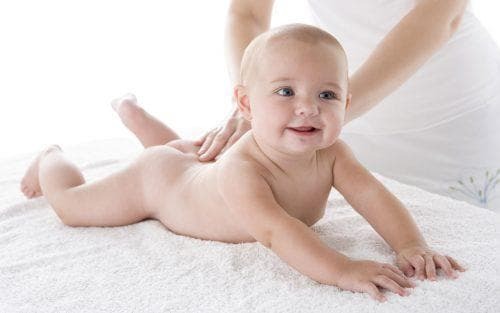
On photo-massage for a child
We examined how laryngospasm manifests itself in childhood. As you can see, the attack of this ailment is quite serious and dangerous. Therefore, special attention must be paid to the prevention and provision of first aid if necessary. In addition, the attack can start suddenly, with nothing before giving out. It is recommended for all parents to better monitor the health of the baby, follow all the recommendations of doctors and carefully consider the prevention of this peculiar and rather dangerous disease.
